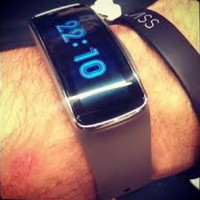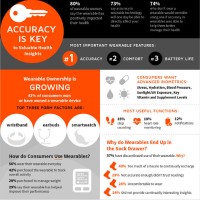Wearables users say accuracy most important feature
A recent national survey on wearable technology devices ("wearables") revealed that consumers consider accuracy the most important feature of wearables, and more than half of those who do not own a wearable would consider buying one if they trusted the accuracy.
The survey findings were announced by Valencell, a leading innovator in performance biometric data sensor technology, and MEMS & Sensors Industry Group, the trade association advancing Micro-Electro-Mechanical Systems (MEMS) and sensors across global markets.
The online survey polled 706 U.S. consumers, ages 18-65, on their knowledge and preferences around wearables, which were defined as a device, clothing and/or accessories incorporating computer and advanced electronic technologies.
Among those surveyed, more than 42 percent of respondents own or have owned a wearable device, and the majority (63 percent) ranked accuracy as a highly important feature of that wearable. Among wearable owners, 80 percent feel that their wearable has a positive impact on their health. For those who do not own a wearable, 74 percent of would consider using one if accuracy in wearables could help them to better manage their health.
"These survey results are testament to Valencell's view that accurate and interesting insights are critical to the success of the wearable industry, and are the biggest drivers of growth today," said Dr. Steven LeBoeuf, president and co-founder of Valencell. "More consumers than ever before are looking to biometric wearables to monitor their health and fitness, and wearables that cannot be trusted for accuracy will ultimately lose out to wearables that have been properly validated."
While most wearable owners find functions such as step counting, heart rate monitoring and notifications most useful, they would also like their wearable to monitor additional health metrics, including stress, blood pressure, sunlight/UV exposure, hydration, and key vitamin and supplement levels.
"MEMS and sensors are critical components in more accurate wearables," said Karen Lightman, executive director, MEMS & Sensors Industry Group. "That's because the devices themselves, from accelerometers, gyros and pressure sensors to heart rate monitors and environmental sensors are delivering ever higher levels of granularity while consuming less power in smaller footprints. Beyond accuracy, MEMS and sensors make wearables more interesting because they literally sense the world around us. With so much advanced functionality now at their disposal, I am convinced that wearables designers will introduce new and compelling products that consumers will consider must-have rather than just nice-to-own."
Key findings of the survey are below. An executive summary of the survey and infographic can also be found at valencell.com/blog.
Accuracy Trumps Cost as a Barrier to Wearable Ownership
Nearly half of all respondents own or have owned a wearable device, with the most popular form factors being wristbands, earbuds and smartwatches. Among notable findings:
- 42% of survey respondents own or have owned a wearable;
- Of those who own a wearable, 52% own a wristband, 36% earbuds and 32% a smartwatch;
- 42% purchased the wearable to track overall activity and 28% purchased to manage weight;
- Of those who do not own a wearable, 31% do not own because they are too expensive and 28% do not own because they are not sure of the benefit of wearables; 58% would consider buying if they trusted the accuracy.
Consumers Want More than Just Step Counting
Consumers who own wearables like to use the data provided to check on progress, and many feel the wearable has helped improve their performance. While respondents find step counting and heart rate monitoring the most useful functions, they would also like to be able to monitor additional health conditions and metrics. These findings support anecdotal stories that consumers care less about the raw metrics and more about assessments derived from raw metrics. Among notable findings:
- 35% of wearable owners feel step counting is the most useful function; 18% find heart rate monitoring most useful; and 12% find the notifications most useful;
- When asked what type of condition they would like to monitor beyond what they are doing now:
- 55% would like to monitor stress
- 48% would like to monitor hydration
- 46% would like to monitor blood pressure
- 38% would like to monitor sunlight/UV exposure
- 35% would like to monitor key vitamin and supplement levels
- When asked what they like most about their wearable:
- 62% like getting data and checking on progress
- 29% like that their wearable has helped improve their performance
- 27% like the accuracy of the data
Accuracy is Key to Valuable Health Insights
Accuracy, comfort, and battery life topped the list of highly important features in wearables. Of those who currently own a wearable, 80% feel that the wearable has positively impacted their health. Among notable findings:
- 63% of all respondents ranked accuracy as a highly important (critical) feature, followed by comfort (57%) and battery life (47%);
- 73% of all respondents believe that accuracy in wearable technology will one day be able to directly affect your health;
- 80% of wearables owners feel that their wearable has positively impacted their health;
- More than 65% of respondents who do not own wearables would consider using one if it provided significant information on their health, including things like blood pressure, stress, and heart health;
- 74% of respondents who do not own wearables would consider using one if accuracy in wearables was able to help them better manage their health;
Of those who own wearables, more than half wear their device every day. However, more than a third have discontinued use of their wearable for reasons that include the hassle of recharging the wearable and their perception that it was not accurate enough and they didn't trust the data. Among notable findings:
- More than 80% have owned their wearable for more than six months;
- 56% wear their wearable every day; 13% wear it once a week;
- 37% have discontinued the use of their wearable;
- Of those who have discontinued using their wearables, 54% stopped using their wearable within 3 months or less;
- Top reasons for discontinuing use of a wearable:
- 40% Too much of a hassle to continually recharge
- 29% Not accurate enough (didn't trust the readings)
- 26% Uncomfortable to wear
- 24% Did not provide continually interesting insights


